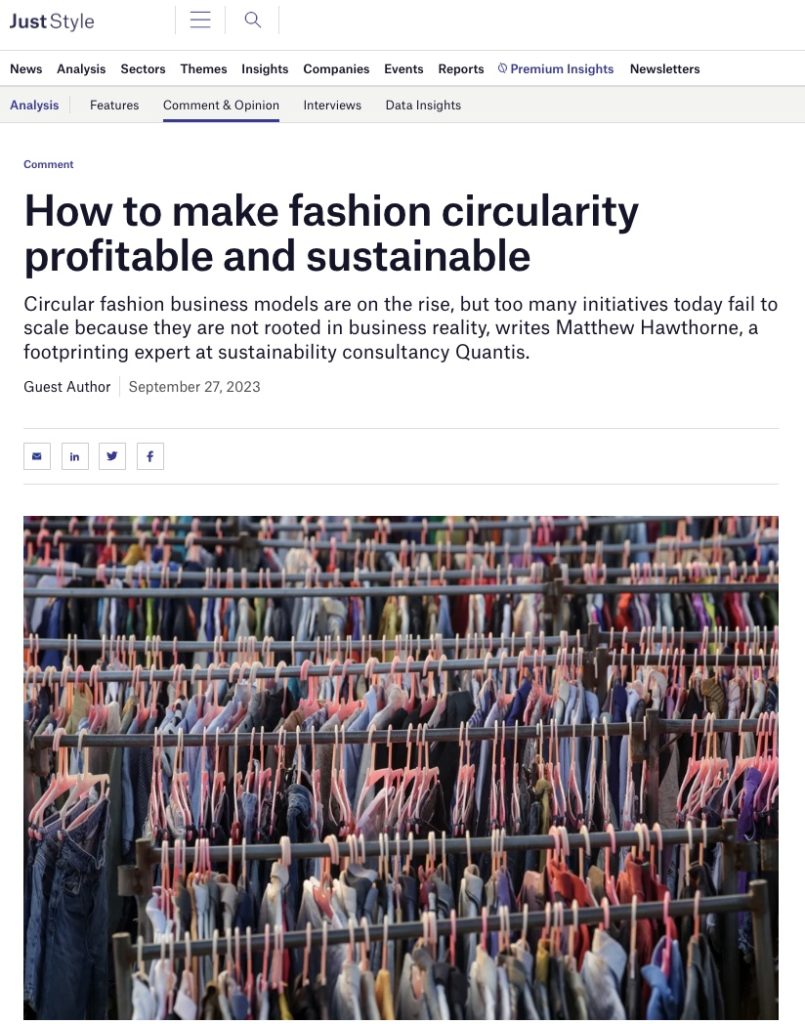This article originally appeared in Just Style.
Just Style | Fashion circularity is still treated as a quick fix – something to be done because of a push for innovation rather than potential solutions to minimise environmental impacts and maximise the creation of sustainable value.
Creating circular business models helps to fully integrate circular principles across a company, aligned to its strategy and long-term sustainability goals. It demands a shift in mindset from the current linear model to consider the lifetime of a product and how it might (or might not) become waste in the future.
Connecting fashion circularity to overall sustainability strategy
In order to be truly transformative and create systemic change, circularity programmes need to consider a broader business perspective, starting with linking their circularity strategy to the overall sustainability strategy and considering the company’s full impact on nature.
The move towards circularity must be both strategic and tactical. During the design phase, product creators and managers will have to apply common circular design principles of durability, repairability and recyclability and adopt renewable or recycled materials. In the use phase, new business models will be required to create engaging and attractive experiences, making it easy for consumers to start changing behaviours and come along for the ride. At the end of life, solutions are needed to collect, recover and reuse valuable materials and products, introducing them back into the natural cycle or in the supply chain.
In the fashion and sporting goods markets there are a series of elements to address, both to business models (internal) and the way in which organisations engage, collaborate and support stakeholders (external).
Simply creating a circular initiative in isolation from the rest of the business might improve one aspect of a company’s environmental impact but shifting the burden could have negative unintended consequences on another.
Rethink products and marketing activities
In fashion, circularity means pushing for models where fewer products are required to satisfy the needs of consumers excited by high-quality and designed-to-last garments. These products tend to be whose life is extended through resale, refurbish and repair, and eventually recycling. Adopting circularity principles and approaches will see brands decouple traditional production from brand growth which can open the door to new revenue streams and transform the way they reduce their environmental impact and manage resources. But if fashion and sporting goods brands are to take advantage of circularity to win market share, they must communicate and engage with consumers and suppliers in a way that educates them on the value of circular products and services, getting them excited about the possibilities.

To establish credibility and longer-term relationships with customers, brands must adhere to solid communications principles that not only inform but influence and drive action. To avoid greenwashing allegations, brands will need to be specific, measurable, relevant, understandable and accessible. Following marketing and communications laws and aligning with ISO standards is crucial.
Offer new ways to create value
By integrating circular product offers into your brand ecosystem, it is possible to create multiple touchpoints and develop new experiences that go beyond the purely transactional sale moment to establish more long-term relationships with consumers.
This could mean connecting digital and physical spaces to leverage a brand’s loyalty programme and using technology to establish deeper connections between consumers and garments. Digital product passports, an idea proposed as part of the EU’s Strategy for Sustainable and Circular Textiles, can improve traceability and act as a useful storytelling mechanism, for example.
It could mean offering repair or upcycling services to interact with consumers during the use phase of their garments, engaging customers once their product has reached the end of its life by offering a takeback service, offering a secondhand range of clothes and rental options, or allowing customers to satisfy their desire to find new styles without producing more. These types of actions will also help enable brands to attract new consumer segments not accessible before.
Design can be used to establish a strong visual identity of products and to educate consumers further by emphasising the concepts of disassembly, modularity and repairability, for example. Boot maker Timberland’s Timberloop marketing efforts are a good example of this, helping city hikers visualise what is involved in end-of-life disassembly.
Build an ecosystem of effective suppliers and partners
Brands must engage the supply chain in the process. Refurbishing, repairing and upcycling garments may not be natural bedfellows to even the most innovative and nimble brand. Developing effective partnerships can decentralise your value chain and provide access to key capabilities that would otherwise be too expensive to build in-house.
Collaborating, pre-competitively, with other brands can also help create the necessary ecosystem, especially when it comes to collecting, sorting, refurbishing and recycling products and materials. Sorting for Circular, a project initiated by Fashion for Good, is bringing together a host of brands to trial the use of near-infrared technology to make garment sorting more accurate and, therefore, valuable for brands that could reuse old clothes.
ReHubs by the European Apparel and Textile Confederation is similarly using the power of the crowd to make it easier and more cost-effective to recycle textile waste at scale, providing a solution to the textile waste flows that will start being collected in Europe as of 2024 as per EU’s new waste legislation.
A recent study of “state-of-the-art practices” in successful circular supply chain management makes a point to highlight companies “collaborating with suppliers from the early design stage” and retailers “increasingly initiating cooperation with manufacturers in modularity, primarily to support a sharing economy.” How? A successful circular system makes space at the designers’ table for inputs from external stakeholders who bring different experiences, diverse competencies and therefore new perspectives, for instance, about the garment’s end-of-life or localised regulatory framework.
Supporting suppliers in shifting practices and building new competencies can help to move entire industry systems towards circularity. After all, if suppliers have the capacity, understanding and desire to deliver circular options for one customer, they are well placed to do so for many more.
It is through this ecosystem that brands will be able to educate consumers more easily on circularity, going beyond single initiatives to guide them on the journey from creation, to use and end of life. In fact, it is something consumers really need. The results of a recent survey by DNV suggest consumers are looking for companies to be more proactive, as one in five respondents mentioned that information about circularity is coming from manufacturers and suppliers directly.
Become profitable
Circular models need to generate revenue that equals or exceeds profits from linear models if they are to survive budget cuts and remain steady components of business operations. No matter how much companies optimise for the environment, if a circular strategy does not make business sense, it will eventually lose its funding and budget allocation.
The fashion and sporting goods industry will need a strong framework to evaluate the success and scalability of these programmes. Companies need clear metrics to track the progress among product categories and business models and provide actionable guidance for effective and long-term implementation. Existing frameworks only focus on environmental impacts, and many don’t even consider biodiversity indicators beyond climate. Without a set of metrics that brands can use to understand not only environmental impacts but also progress toward impact reduction, companies will struggle to prove value and justify investments in circular models. An effective framework should be able to:
- Maximise environmental value. It should focus on resource retention to make the most out of a company’s products and materials.
- Minimise environmental drivers. By taking a holistic approach to circularity, a good framework helps minimise a company’s impact on issues like climate change and biodiversity loss.
- Optimise (re)circulation. It broadens the view of a product’s lifecycle to include recirculation, considering environmental impacts during a product’s use phase and extension of life.
- Maintain business imperatives. A strong environmental framework is supported by traditional business metrics to ensure the solution will help drive long-term business transformation and move beyond the pilot stage.
Every brand’s solution to circularity will look different based on its product portfolio, environmental goals and business imperatives. For example, a resale strategy will not be successful for intimates and a repair strategy will not work for pantyhose and stockings. Working with external partners against a set framework will help brands understand and implement proper metrics, strategy and a clear, actionable roadmap.
Circularity is not about the short-term gain. Without connecting circularity initiatives to overall sustainability strategy and the ability to assess the success and scalability of circular programmes, the fashion industry will not be able to transform at scale. Many businesses have already started to incorporate circularity into their practices as a way of meeting their sustainability goals and ensuring future economic success. It is time for brands to follow the same path by using circularity to build their competitive advantage and resilience for tomorrow.
Latest resources

How digitalization is unlocking a new era of sustainability in fashion...
While digitalization alone doesn’t guarantee perfect accuracy, it plays a crucial role in many ways like fostering more meaningful supplier engagement, boosting data quality and...

Why an environmental sustainability strategy without nature is incomplete
Businesses have an essential role to play in reversing the trend of nature loss — and a lot to lose from inaction.

Purpose: The 5th ‘P’ in the sustainable food + beverage marketing ...
The 5th 'P' in the marketing mix, purpose, adds depth to product, price, place, and promotion, enabling greater sustainability and impact.

